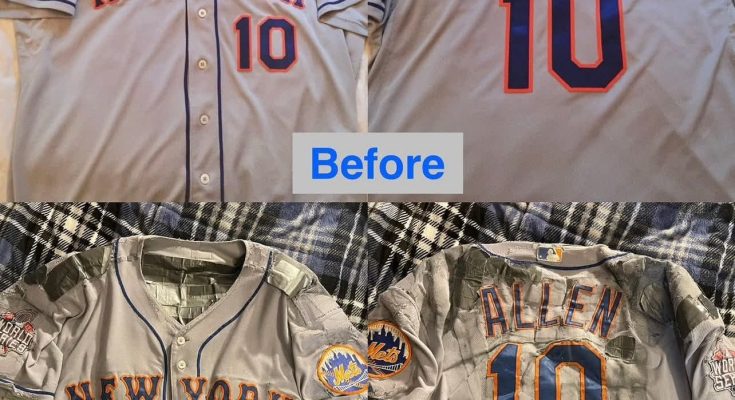For the past ten years, this Mets fan has worn the same jersey every single day, a jersey that is now more than just fabric and stitching—it is a symbol of unwavering loyalty, hope, and a sort of stubborn optimism that borders on the heroic. It is a 2015 World Series jersey, a season that did not end in triumph but one that sparked dreams, late-night conversations, and countless “what if” moments that have lingered in the fan’s mind for a decade. To outsiders, the jersey might seem like a relic, perhaps a reminder of disappointment or a quirky expression of fandom, but to him, it is much more than that. It is a daily ritual, a testament to perseverance and faith in a team that has often been defined by heartbreak and near-misses. Wearing it every day has become a part of his identity, so intertwined with who he is that it is impossible to separate the fan from the garment. The jersey carries the weight of memories, the echoes of cheers and groans from Citi Field, the smell of hot dogs and peanuts, the collective roar of a stadium, and the silent, personal moments of reflection when the game was lost in the final innings. Each morning, as he puts it on, it is not merely clothing—it is armor, a shield against the disappointments of the past and a statement of defiance against the inevitability of letting go. For ten years, it has accompanied him through ordinary life—commutes, meetings, errands, nights out, and quiet evenings at home. It has been to grocery stores, bars, friends’ houses, and family gatherings, each time silently declaring loyalty that is absolute and unconditional. People who know him well understand that this jersey is not just a sports garment; it is a symbol of resilience, a visual metaphor for never giving up on what you love even when the odds are overwhelmingly against you. They see the holes in the fabric from repeated wear, the faded patches, the fraying at the edges, and they understand that every mark tells a story. The stains from spilled drinks at games, the threads that have come loose from decades of cheering, and the occasional tear from a particularly emotional moment—these are not imperfections. They are badges of honor, evidence of a decade-long journey that transcends wins and losses.
The 2015 season was supposed to be the turning point. The Mets had a strong roster, a passionate fan base, and the kind of momentum that ignites hope across an entire city. That year, every game felt electric, each play imbued with the possibility of greatness. The jersey he now wears daily was purchased in anticipation of victory, a talisman to accompany the team to the pinnacle of baseball achievement. He remembers the first time he put it on—the feel of the fabric against his skin, the number and name emblazoned across the back, and the sense of anticipation that came with it. There was a naïve certainty in those early days, a belief that this jersey might witness the culmination of years of fandom and patience. He imagined the parade through Manhattan, the champagne in the streets, the cheering crowds, and the glory of finally seeing the Mets lift the World Series trophy. When the season ended without that triumph, the jersey did not come off. He could have, of course, hung it in the closet, washed it occasionally, and tucked it away as a memory of a season that almost was. Many fans would have done so. But he did not. Instead, he made a silent promise, one that has now endured for a decade: he would continue wearing it every day until the Mets finally won the World Series. It is a personal pact, a covenant between himself and a team, a way to maintain hope when hope seemed fleeting. There is something deeply human about such acts, something that resonates with anyone who has ever committed themselves to a goal or belief so fully that it becomes inseparable from their sense of self.
Every year since 2015 has brought its own trials and tribulations, both on the field and in life. Seasons have come and gone, some filled with promise, others with heartbreaks that seemed almost unbearable. Through it all, the jersey has remained constant, an unchanging presence in a world of unpredictability. It has been worn during the Mets’ highs and lows, through playoff runs that fell short and seasons that ended in mediocrity. Friends and family have occasionally questioned him about it, asking if he will ever stop, if he will ever move on. But the answer is always the same: not until the Mets win the World Series. To do otherwise would feel like betraying the faith he has invested in his team, a faith that has survived more disappointment than most people could bear. The jersey has become a part of his daily routine, as natural as brushing his teeth or making coffee in the morning. It is comforting in its consistency, a small act of devotion that brings structure and meaning to each day. Even on days when the news is grim, when the team loses in ways that feel devastating, or when life itself presents challenges, putting on the jersey serves as a reminder of patience and resilience. It is a quiet act of hope, a subtle rebellion against the idea that disappointment should lead to giving up.
Over the years, the jersey has taken on a mythology of its own among those who know him well. It is not just a garment; it is a living symbol of perseverance. Stories circulate about how he once wore it through a particularly rough week at work, how he refused to take it off even during a family gathering when the Mets lost a critical game, or how he washed it sparingly, fearing that laundering it might somehow wash away the luck it carries. For some, it is a curiosity, a quirky anecdote about a devoted fan. For others, it is inspirational, a lesson in loyalty, endurance, and the human capacity for hope. The jersey is both a personal item and a cultural artifact, connecting him to the broader story of Mets fandom, a story defined by highs, lows, near misses, and the enduring hope that victory will one day arrive.
People who pass him on the street or see him in public may not fully grasp the significance of the jersey. To them, it may appear as simply an old piece of sports apparel. But to him, it is deeply imbued with meaning. Each time he puts it on, he recalls the roar of the crowd at Citi Field, the smell of the concession stands, the exhilaration of a perfect pitch, the heartbreak of a game lost in the ninth inning, and the shared camaraderie of thousands of fans united by passion and disappointment. The jersey serves as a bridge between the personal and communal experience of sports fandom, linking him not only to his own memories but to the memories of countless other fans who have experienced similar highs and lows. It is a wearable archive of emotion, a tangible connection to a decade of dedication.
Despite the passage of ten years, his commitment has not wavered. There have been moments of doubt, certainly, times when it would have been easier to place the jersey in the back of a closet or donate it to a charity shop. Life circumstances—moving to new cities, changing jobs, personal challenges—have provided opportunities to abandon the ritual. Yet he has never done so. The act of wearing the jersey daily has become a grounding force, a source of continuity amid the chaos of life. In a world where so much is fleeting, where careers, relationships, and even seasons come and go with alarming speed, the jersey remains a constant. It is a reminder that some commitments are worth maintaining, even when they test patience and endurance.
He has often reflected on what it means to wear a single jersey for so long. There is a meditative quality to it, a daily reminder of values like loyalty, hope, and perseverance. It is a practice in delayed gratification, in learning to embrace uncertainty, and in understanding that meaningful outcomes often take time. In a way, it mirrors life itself—long, unpredictable, full of disappointment, but also punctuated by moments of joy and triumph. Every time he looks in the mirror and sees the familiar colors, the number, and the name, he is reminded of the narrative he has committed to, a narrative that is not yet complete but whose continuation depends on patience and faith.
The jersey has also become a social symbol. When other Mets fans recognize it, nodding or waving in acknowledgment, it creates a sense of shared history and understanding. They do not need to speak to each other to convey meaning; the jersey itself communicates devotion, passion, and an unbreakable bond with a team that has shaped their lives in profound ways. It tells the story of fandom, of enduring loyalty, of refusing to abandon hope even when circumstances seem bleak. The 2015 jersey is more than a piece of cloth; it is a badge of identity, a marker of membership in a community that values commitment over convenience.
He sometimes jokes that he is training the jersey to see the Mets win, that the longer he wears it, the more powerful it becomes, the more luck it attracts. While humorous on the surface, there is a truth to this sentiment: the act of consistent devotion can have a subtle, transformative power over the individual. Wearing the jersey is both a personal ritual and a statement to the world: that he will not let disappointment dictate his actions, that he will remain steadfast in his passions, and that hope, however long delayed, is always worth nurturing.
Friends and family have come to accept, and even admire, this unusual dedication. They see that it is not mere obsession but a profound expression of identity, an articulation of values through a simple daily practice. The jersey represents more than loyalty to a sports team; it embodies commitment, endurance, and the courage to maintain belief even in the absence of immediate reward. It is a tangible manifestation of hope, one that grows stronger with time, and one that will only reach its ultimate fulfillment when the Mets finally win the World Series.
For ten years, the jersey has been a companion through life’s ordinary and extraordinary moments. It has witnessed personal triumphs and defeats, travel and relocation, birthdays and holidays, quiet nights and celebrations. Each day it is worn, it carries the memory of the Mets’ 2015 season, the hopes and dreams of countless fans, and the deeply personal pledge of one individual who refuses to let go. It is a testament to the human capacity for hope and perseverance, a reminder that some acts of devotion are meaningful not because they guarantee a particular outcome but because they define who we are. In the end, it is not just about winning a championship; it is about showing up every day, about remaining steadfast in the face of disappointment, and about finding meaning in the act of devotion itself. This Mets fan’s 2015 World Series jersey is a symbol of everything it means to believe, to hope, and to endure, and it will continue to be worn every day until the day finally comes when the Mets lift that long-awaited trophy, at which point the fabric, frayed and faded though it may be, will have borne witness to a decade of unwavering faith and love.
The jersey, with all its marks of time and wear, represents more than a team or a season; it represents a personal journey, a living chronicle of ten years of loyalty. It embodies the quiet power of consistency, the resilience of hope, and the beauty of commitment. In a world where trends come and go and where many are quick to abandon what seems lost, this fan has chosen a different path. He has chosen to wear his devotion visibly, daily, and without compromise. The 2015 Mets World Series jersey is now inseparable from him; it is not just something he wears but something he lives, a piece of identity that tells a story of hope, of waiting, and of the enduring power of belief. One day, the day he has long envisioned, the Mets will win the World Series, and that jersey will have seen it all—from the anticipation to the heartbreak to the ultimate triumph. Until that day, he will continue to wear it, a living testament to the human spirit and the enduring love of a fan for his team, a love that does not fade, does not waver, and does not give up.



